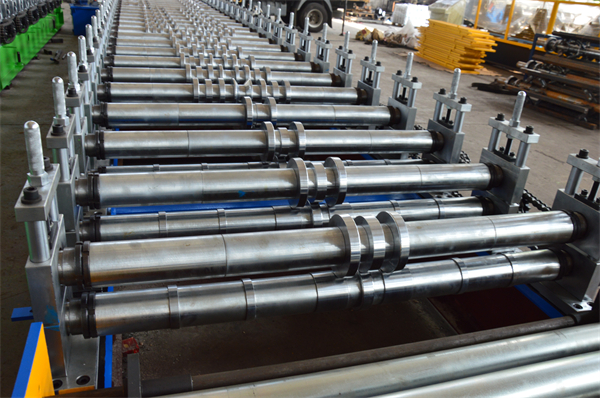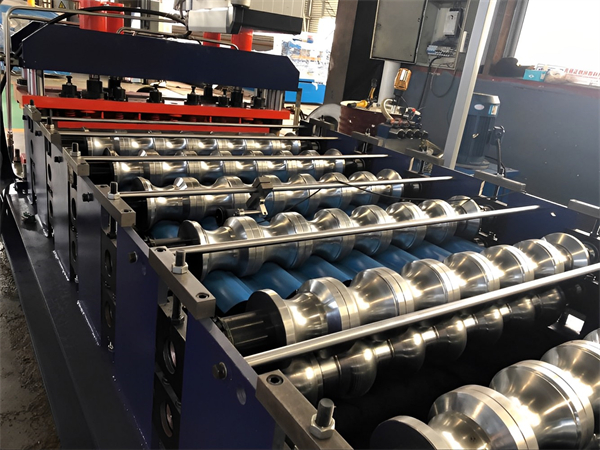1. Pendahuluan
Dalam dunia fabrikasi logam, mesin roll forming berperan penting dalam membentuk dan mengubah lembaran logam menjadi berbagai macam profil yang digunakan dalam bidang konstruksi, otomotif, dan industri lainnya. Di antara sekian banyak mesin roll forming yang tersedia, mesin mesin pembuat gulungan trapesium menonjol karena keserbagunaan, efisiensi, dan berbagai aplikasinya.
2. Apa itu Mesin Roll Forming Trapesium?
Mesin roll forming trapesium adalah peralatan khusus yang digunakan untuk membuat profil logam berbentuk trapesium. Profil ini, yang dikenal dengan bentuknya yang khas seperti trapezium, banyak digunakan dalam konstruksi atap, dinding, lantai, dan komponen rangka.
3. Prinsip Kerja Mesin Roll Forming Trapesium
Pengoperasian mesin pembuat gulungan trapesium didasarkan pada proses pembengkokan yang berkelanjutan. Lembaran logam datar dimasukkan ke dalam rol mesin, di mana serangkaian stasiun secara bertahap membentuk logam menjadi profil trapesium yang diinginkan.

4. Keuntungan Menggunakan Mesin Roll Forming Trapesium
4.1 Peningkatan Kecepatan Produksi
Mesin roll forming trapesium menawarkan kecepatan produksi yang mengesankan, memungkinkan produsen memenuhi tenggat waktu proyek yang ketat dan meningkatkan produksi mereka secara efisien.
4.2 Keserbagunaan dalam Bentuk Profil
Meskipun tujuan utama mesin ini adalah untuk menghasilkan profil trapesium, namun mesin ini juga dapat diadaptasikan untuk memproduksi bentuk lain dengan penyesuaian minimal.
4.3 Efisiensi Biaya dan Penghematan Bahan
Proses roll forming meminimalkan limbah material, sehingga menjadi pilihan yang hemat biaya dibandingkan dengan metode pembentukan logam lainnya.
4.4 Output yang Konsisten dan Berkualitas Tinggi
Mesin roll forming trapesium memberikan profil yang konsisten dan presisi, memastikan output berkualitas tinggi yang memenuhi standar industri.
5. Aplikasi Mesin Roll Forming Trapesium
5.1 Lembaran Atap dan Kelongsong
Profil trapesium biasanya digunakan dalam konstruksi atap dan lembaran cladding, menawarkan ketahanan terhadap cuaca dan integritas struktural yang sangat baik.
5.2 Panel Dek Lantai
Mesin ini mampu memproduksi panel dek lantai yang digunakan pada bangunan bertingkat, memberikan dukungan yang kuat dan kapasitas penahan beban.
5.3 Panel Dinding dan Pelapis Dinding
Profil trapesium dapat diaplikasikan dalam pembuatan panel dinding dan pelapis dinding yang menarik dan tahan lama.
5.4 Purlins dan Komponen Rangka
Mesin ini dapat membuat purlins dan komponen rangka untuk berbagai struktur, memastikan stabilitas dan umur panjang.
6. Komponen Utama dari Mesin Roll Forming Trapesium
6.1 Uncoiler
Uncoiler memegang kumparan logam dan memasukkannya ke dalam mesin roll forming, memastikan proses produksi yang berkelanjutan.
6.2 Stasiun Pembentuk Gulungan
Stasiun ini terdiri dari rol dan cetakan yang secara bertahap membentuk logam ke dalam profil trapesium yang diinginkan.
6.3 Mekanisme Pemotongan
Mekanisme pemotongan memungkinkan pemotongan panjang yang tepat dari profil yang dibentuk, memastikan keseragaman dan akurasi.
6.4 Sistem Kontrol
Sistem kontrol mengoperasikan dan mengatur alat berat, memungkinkan penyesuaian dan pemantauan proses produksi yang mudah.
6.5 Sistem Penumpukan dan Pengemasan
Sistem ini mengumpulkan dan menumpuk profil yang sudah jadi, merampingkan proses pengemasan dan distribusi.

7. Faktor yang Perlu Dipertimbangkan Saat Memilih Mesin Roll Forming Trapesium
7.1 Ketebalan dan Lebar Material
Memilih mesin yang dapat mengakomodasi ketebalan dan lebar material yang diinginkan sangat penting untuk produksi yang optimal.
7.2 Kecepatan dan Kapasitas Produksi
Produsen harus mengevaluasi kecepatan dan kapasitas produksi alat berat untuk memastikan alat berat tersebut memenuhi persyaratan proyek mereka.
7.3 Opsi Kustomisasi Profil
Pertimbangkan mesin yang menawarkan fleksibilitas dalam kustomisasi profil untuk memenuhi permintaan pelanggan yang beragam.
7.4 Dimensi Mesin dan Kebutuhan Ruang
Ruang kerja dan ruang lantai yang tersedia harus dipertimbangkan untuk menentukan ukuran mesin roll forming yang sesuai.
7.5 Anggaran dan Pengembalian Investasi (ROI)
Memahami investasi awal dan potensi ROI membantu dalam membuat keputusan pembelian yang tepat.
8. Pemeliharaan dan Pemecahan Masalah Mesin Roll Forming Trapesium
8.1 Praktik Perawatan Rutin
Menerapkan praktik perawatan rutin memastikan umur panjang dan kinerja alat berat yang efisien.
8.2 Masalah Umum dan Kiat Pemecahan Masalah
Mengidentifikasi dan menyelesaikan masalah umum dengan segera meminimalkan waktu henti dan memastikan produksi yang berkelanjutan.
9. Pertimbangan Keamanan Saat Mengoperasikan Mesin Roll Forming Trapesium
9.1 Pelatihan dan Kompetensi Operator
Pelatihan dan sertifikasi operator yang tepat mendorong pengoperasian alat berat yang aman dan mencegah terjadinya kecelakaan.
9.2 Fitur Pengaman dan Keselamatan Mesin
Alat berat yang dilengkapi dengan fitur keselamatan dan sistem pelindung meningkatkan keselamatan operator selama proses produksi.
9.3 Menangani dan Menyimpan Bahan dengan Aman
Panduan untuk menangani dan menyimpan bahan membantu mencegah cedera dan menjaga kualitas bahan baku.
10. Tren Masa Depan dalam Teknologi Pembentukan Gulungan Trapesium
Seiring dengan kemajuan teknologi, mesin roll forming trapesium kemungkinan besar akan menggabungkan otomatisasi dan kontrol cerdas, yang semakin meningkatkan efisiensi dan produktivitas.

11. Kesimpulan
Mesin roll forming trapesium telah merevolusi industri produksi profil logam dengan efisiensi, keserbagunaan, dan hasil yang berkualitas tinggi. Mesin ini terus memainkan peran penting di berbagai sektor, menawarkan solusi yang hemat biaya dan dapat diandalkan untuk membentuk profil logam. Dengan kemajuan yang terus berlanjut, masa depan teknologi roll forming trapesium terlihat menjanjikan, menjanjikan inovasi lebih lanjut dan proses manufaktur yang lebih baik.
FAQ
Apa yang membedakan mesin roll forming trapesium dari mesin roll forming lainnya?
Mesin roll forming trapesium dirancang khusus untuk menghasilkan profil trapesium, yang biasanya digunakan dalam aplikasi atap, kelongsong, dan konstruksi. Keserbagunaan, efisiensi, dan kemampuannya untuk membentuk profil yang kompleks membedakannya dari mesin roll forming lainnya.
Apa saja komponen utama dari mesin roll forming trapesium?
Mesin roll forming trapesium terdiri dari uncoiler, stasiun roll forming, mekanisme pemotongan, sistem kontrol, dan sistem penumpukan dan pengemasan. Setiap komponen memainkan peran penting dalam produksi profil trapesium yang mulus.
Jenis bahan apa yang dapat digunakan dengan mesin roll forming trapesium?
Mesin roll forming trapesium dapat bekerja dengan berbagai macam bahan, termasuk baja, aluminium, dan logam lainnya. Pilihan bahan tergantung pada aplikasi spesifik dan sifat yang diinginkan dari produk akhir.
Bagaimana produsen dapat memastikan keselamatan operator yang menggunakan alat berat ini?
Produsen harus memberikan pelatihan yang tepat kepada operator untuk memastikan mereka memahami pengoperasian mesin dan protokol keselamatan. Selain itu, mesin roll forming trapesium harus dilengkapi dengan fitur keselamatan, seperti pelindung dan tombol berhenti darurat, untuk melindungi operator selama proses pembuatan.
Apa saja persyaratan perawatan untuk mesin roll forming trapesium?
Perawatan rutin sangat penting untuk menjaga mesin roll forming trapesium dalam kondisi kerja yang optimal. Ini termasuk pembersihan, pelumasan, pemeriksaan komponen, dan penggantian suku cadang yang aus secara tepat waktu. Mengikuti panduan perawatan dari pabrik sangat penting untuk memaksimalkan masa pakai mesin.
